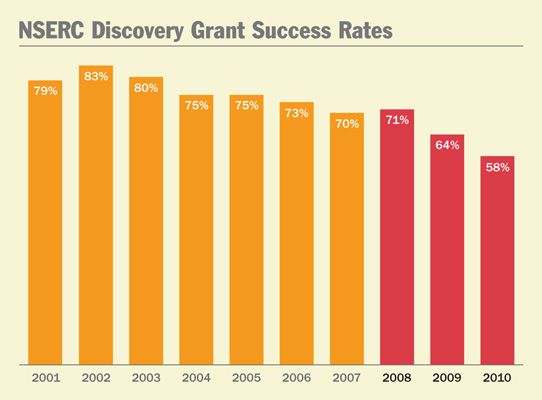
Canada’s academic scientists and engineers are increasingly anxious about the effectiveness of the Natural Sciences and Engineering Research Council’s Discovery Grant Program after only 58 per cent of applications were successful in the 2010 competition.
The program’s success rate has been on a downward spiral over the past three years as changes in the award system are being implemented at NSERC — from 71 per cent in 2008 to 64 per cent in 2009 and falling to a record-low level of 58 per cent this year.
“It’s a disturbing trend,” said James Turk, executive director of CAUT. “The Discovery Grant Program is the main funding source for fundamental research in the natural sciences and engineering. The declining success rate will reduce the broad research capacity necessary to seek solutions to the many complex problems facing Canadian society and our economy.”
NSERC recently reported that it intends to make the program even more selective by increasing the level of competitiveness for funding among researchers, with some proposals receiving higher amounts of funding.
Turk said NSERC’s ideology of increased selectivity was baffling given previous reviews of the program had concluded the opposite.
The agency asked an international panel of experts to review its program in 2007. The panel found that the program was exceptionally effective in international comparison and in “maintaining a diversified base of high quality research capability in Canadian universities.” The panel warned NSERC that “any significant intentional reduction in the DGP success rate…would result in reduced research support in the smaller provinces and in small institutions.”
An internal program review also initiated in 2007 showed that program funding was insufficient to match the increasing numbers of university researchers hired over the past decade, while the average discovery grant had not kept pace with inflation.
“The core problem continues to be the underfunding of research provided through the three granting agencies,” Turk said. “This is exacerbated by the fact that more and more funds are being targeted within NSERC towards industry-university partnerships and commercialization initiatives.”
The Discovery Grant Program accounted for two-thirds of NSERC’s budget at the Council’s creation in 1978, and now hovers around 33 per cent.
The situation for academic researchers will get worse as NSERC plans to cut $14.5 million from discovery grant expenditures over the next three years.